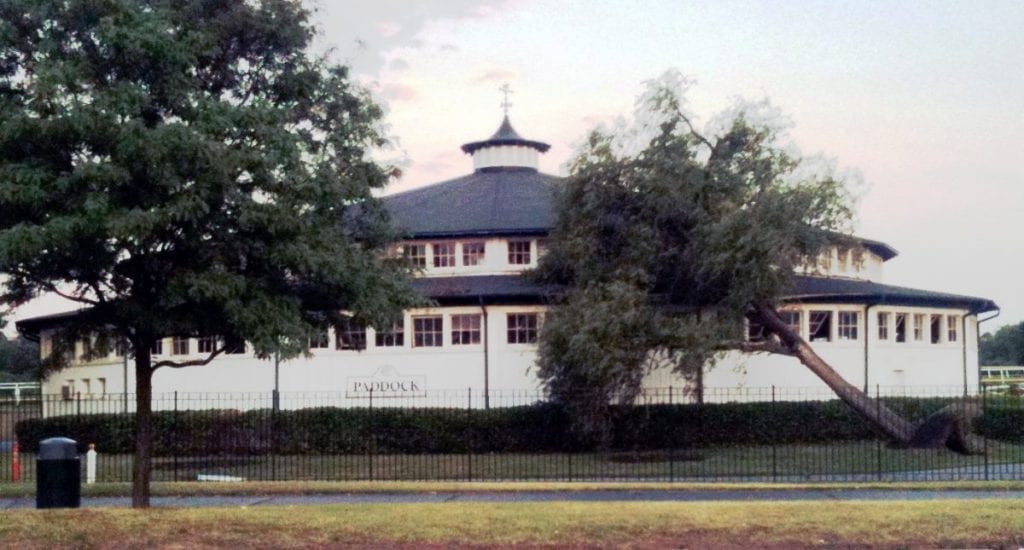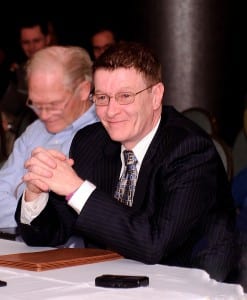by Frank Vespe
Days of speculation reached their anticipated conclusion this morning, when the Stronach Group announced the resignation of Maryland Jockey Club (MJC) President and Chief Operating Officer Tom Chuckas after more than six years at the helm, with Parx Racing Director of Racing Sal Sinatra set to replace him.
Stronach Group Chief Operating Officer Tim Ritvo, in a conference call with reporters this morning, suggested that that means that change — but not too much change — is coming to Maryland, and mid-Atlantic, racing.
The Stronach Group owns the Maryland Jockey Club, which operates Laurel Park, Pimlico Race Course, and the Bowie Training Center.
“First, I want to reassure the Stronach Group’s commitment to Thoroughbred racing,” Ritvo told the dozen or so reporters. “We would like to see Maryland become as big a force as we think it can be.
“We want to continue to build the sport and be prominent in the industry. Maryland is a key component of that,” Ritvo added.
Rumors of the impending changes had begun to swirl around Laurel Park nearly two weeks ago.
The Maryland Jockey Club’s business performance had suffered in the earlier years of Chuckas’ tenure, as other nearby tracks, fueled by slot machine subsidies, had put the squeeze on the Maryland product. More recently, however, Chuckas had played a key role in the industry’s crafting of a 10-year agreement to govern racing; and, with slots-enhanced purses, the product, and handle, have improved. Chuckas also oversaw changes in Preakness weekend — including changes in alcohol policies and boosting the profile of Black-Eyed Susan day — that have led to growth for the company’s signature event.
“We are very thankful for all Tom has done, especially the Preakness,” Ritvo said.
Local horsemen valued Chuckas’ openness.
“Over the last seven years, Tom’s been a great partner with the horsemen and with the MTHA,” said Maryland Thoroughbred Horsemen’s Association (MTHA) president Tim Keefe. “We’re disappointed to lose him.”
And Bruce Quade, chairman of the Maryland Racing Commission, said that in recent years, Chuckas had been “a major force in Maryland racing.” He added, “A lot of the good things that have happened over the last couple of years, he’s played an integral part.”
Ritvo portrayed the hiring of Sinatra as primarily done to “build the strongest racing team” and indicated that he had not sought Chuckas’ resignation.
But he also suggested that Maryland racing’s future may begin to look a little bit different. Improving handle, rejuvenating the aging facilities, and working to promote greater regional cooperation are all on the agenda.
“I would like to get some more eyeballs on the product,” Ritvo said, pointing out that Laurel’s terrific De Francis Dash day card, probably the best racing card in the country on that day, handled $3.2 million — good business for Laurel these days, but lagging far behind many other tracks.
“We want to signify to the bettors [that Maryland racing is back],” Ritvo said.
He allowed that there are “no silver bullets,” but he did point at least twice to takeout as one area to review.
He indicated that he would favor lowering the rake if “adjusting our takeout downward is what it would take to get eyeballs back on the product,” though he also said that no decision on that would be made without consultation with the horsemen.
Another potential area of change is the facilities themselves — a sore spot for horsemen and racing fans for many years. The MTHA’s Keefe called the condition of Laurel’s grandstand “deplorable” and said that an important question the state’s horsemen are asking is, “What are their intentions for Pimlico? What are the plans for Laurel?”
Ritvo said that the MJC would break ground on the long-promised new barns at Laurel “right after Thanksgiving.” Under the 10-year agreement, building those barns is necessary to enable the company to close down the Bowie Training Center — a goal it has long held, though one Ritvo did not reiterate today.
Though vague, Ritvo also added that within six months, the company would make “an announcement of a solid plan of what Maryland racing could be.”
He added, “These [capital] plans have been on the drawing board way too long… [I]t’s time to move Maryland forward.”
Finally, Ritvo suggested that greater regional cooperation was in the offing. He said that the company was in the early stages of conversations with racing interests in Virginia, Delaware and possibly Pennsylvania advocating what he called “a more cohesive racing schedule.”
He said that he hoped in future years to see “an expanded race schedule but a cooperative one,” with the region’s tracks working together to maximize racing opportunities while minimizing head-to-head competition. “We’re out there saying to racinos [such as Delaware Park and Parx Racing], ‘Are you willing to work with us on cooperative racing schedules?'”
Sinatra, the Director of Racing at Parx since 1999, will be the man tasked with implementing those plans. Under his leadership, despite a middling day-to-day product, Parx has significantly grown its two signature events — the Grade 1 Cotillion and the Grade 2 Pennsylvania Derby. Those races this year attracted Kentucky Derby and Preakness hero California Chrome and Untapable, a shoo-in for the year’s top three-year-old filly.
Pointing to Sinatra’s “love for horse racing,” Ritvo added, “We think Sal has a lot to offer.”
As for the always-important political realm, Ritvo said that he hoped the changes would not impact the MJC’s relationship with the Maryland Racing Commission or legislative leaders in Annapolis, adding, “We are aware that Maryland is a very political state.”
He said the company would strive to make the Maryland racing product one that the state’s political leadership “can be proud of.”
On that, everyone can agree.
“We on the Maryland Racing Commission hope that the turnaround in Maryland racing will continue to flourish,” Quade said.












Good news and something to potentially be thankful for, appropriately on the eve of Thanksgiving… a stronger Mid-Atlantic region where all tracks can put their differences aside and cooperate with one another.
Can hardly wait for the next t6 months to pass to find out what the “…solid plan of what Maryland racing can be” will be.
I would say you’re not the only one eager to see what the solid plan is…
Maybe the Stronach Group should look to their own HRTV to increase handle. First, he sued or threatened to sue TVG (can’t really remember) to remove Maryland Racing from TVG (which currently reaches many more households than HRTV) and now that Laurel Park is only on HRTV, the executives there continually remove Laurel live racing from its show. Too many times on Saturdays, after say race 3 or 4, they say “and that will be the last race we show from Laurel Park today”. I even heard that Maryland Million races were shown on tape delay all in favor of tracks that he has no more connection with, like Churchill. Can the Stronach Group actually say with a straight face that they are doing all they can to promote Maryland Racing?
Michael,
Great points about TVG and HRTV. Tvg is in 33 million households and HRTV limps in at 19 million households. Also, Laurel Park has barely any presence in the Daily Racing Program. A track like Gulfstream West (which is really Calder) had about the same purse structure as Laurel; killed Laurel Park in gross handle this fall. I would kill to be in Laurel’s marketing department for a month to help get the word out about the great product Laurel is offering.